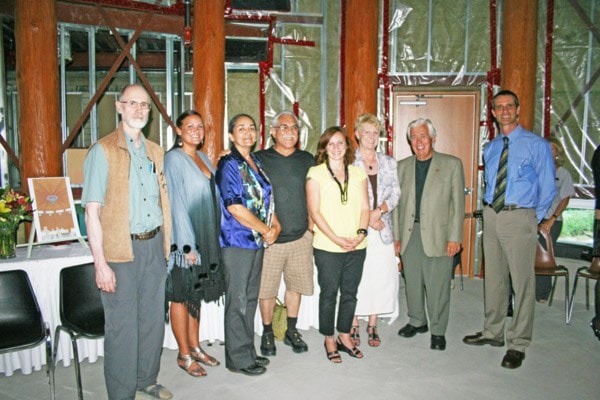Selkirk College President and CEO Angus Graeme, along with several dignitaries and representatives from Aboriginal groups kicked off the final leg of fundraising for the Aboriginal Gathering Place at Selkirk College in Castlegar. The kick-off event, entitled 'Completing the Circle', took place at the Gathering Place, which is nearly completed.
The college is looking to raise the final $150,000 necessary to complete the project. The Gathering Place is a structure which will be utilized to promote Aboriginal culture, ceremony and provide an environment that is welcoming and relevant to Aboriginal students, their families, and the community at large.
"We want this to be a gathering place for both Aboriginal and non-Aboriginal people to really celebrate the rich and diverse culture of our college," said Graeme. "In particular for our young and returning learners. We have to connect learning to cultural and spiritual tradition if our Aboriginal learners are going to be more successful."
Selkirk College previously received $600,000 from the government and $200,000 from Columbia Basin Trust to support the $950,000 project. The Aboriginal Gathering Place is part of a program from the provincial government to build Gathering Places on post-secondary campuses throughout B.C.
"These are in many instances the only facilities in urban centres for Aboriginals to gather in," said Gwen Phillips, director responsible for governance transition and traditional knowledge and language. "Having them located in the local community colleges is a real opportunity to bridge the gap between arriving at a college in a non-threatening way.
"A lot of times Aboriginal people, First Nations people, have had poor experiences in their public school years," Phillips continued. "Some have even come from residential schools and had poor experiences there, and haven't participated in post-secondary school at all – fearful of even the prospect of participation. We're finding these kind of facilities (the gathering places) in providing services and programs that aren't the standard academic programs are a really important bridge to making that move forward."
Phillips said that the programs made available for Aboriginal learners such as essential skill development and confidence building will help students make the move up the educational ladder.
"Post-secondary education as we know is one of the keys to advancing socio-economic status. We know the First Nations and Aboriginal peoples of Canada have a far lower socio-economic status than that of mainstream Canadians," said Phillips. "So we're hoping and we're seeing evidence that these kinds of facilities are useful in providing those kinds of opportunities to get people together to gain the confidence, the skills, the access, and to network, to provide them with the support to get on with their education and with their lives."
